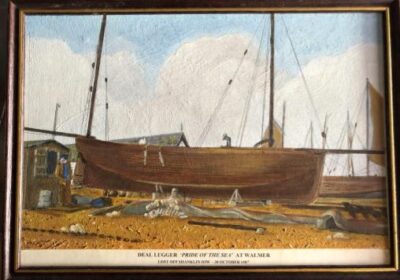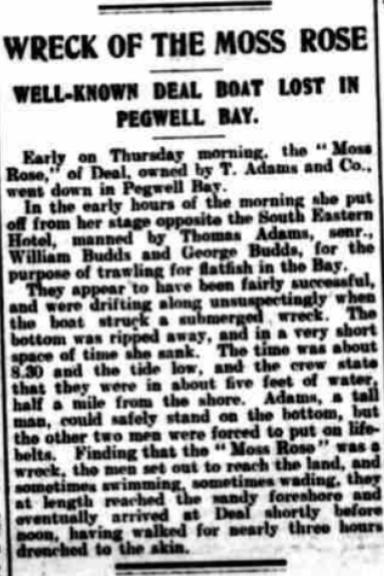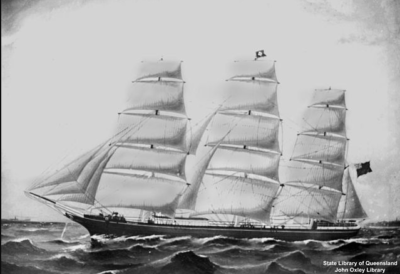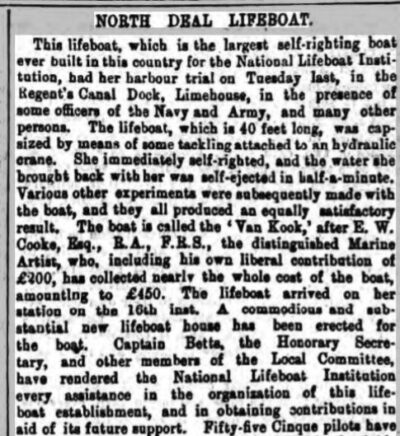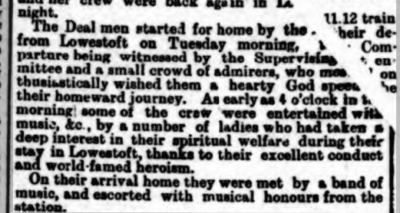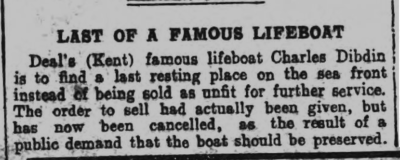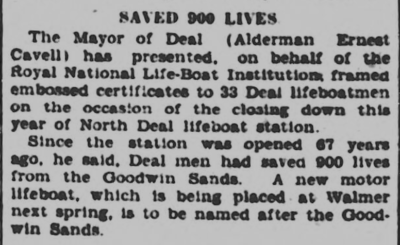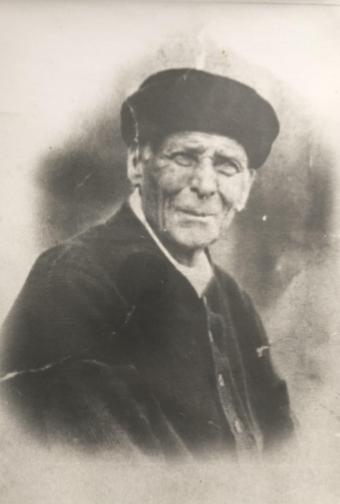Follow us on Facebook @FHofDW
Thomas Adams
120 Beach Street
12 Griffin Street
7 Farrier Street
1 Jubilee Cottages, High Street
Occupation: Mariner, Lifeboatman
Pride of the Sea
The Pilot Lugger Pride of the Sea, with its six crew, left Walmer on the morning of 14 October 1887 to cruise down the Channel looking for ships requiring Pilots. On the morning of Thursday, 27th Thomas Adams was shipped on board ‘Knight Companion’ which was bound for Dunkirk. Little did he know that would be the last time he was to see his friends and crew mates.
On the morning of the 30th, after being caught in a severe South Easterly Gale, Pride of the Sea was driven ashore at Shanklin, Isle of Wight. All five of the remaining crew, John Moss, William Moss, Charles Moss, Charles Selth and Henry Kirkaldie were eventually washed up on the beaches near Shanklin Cove.
News would probably have reached Deal & Walmer of this disaster the following day. Thomas or Tom knew nothing of this until he reached home on the evening of Monday 31st. He’d landed at Dunkirk then caught a Channel packet boat to Dover and from there he walked on home. Imagine the reaction of the people as he walked through Walmer then into Deal.
Tom had been married to Julia Trapps for just over 8 years at the time, and by then had had five children so his sudden appearance, within hours of the news of the loss of Pride of the Sea, must have brought both joy and great relief.
The loss of a bread winner at this time could lead to poverty and the workhouse. To give the families some relief at such times subscriptions were set up as was the case for the families of Pride of the Sea. Collections were made in Shanklin, where the men were fairly well known as well as in Deal and Walmer. Just over £363 was collected and equally divided between the families of the lost men and another £10 was, at the request of the people of Shanklin, paid to Tom Adams. What he felt about this generous gesture can only be guessed at. We do know that he thought highly of his lost crew mates saying he had never sailed with “…a pleasanter boats crew …” and in all the time that he had been one of the crew he never heard an angry or unkind or unpleasant word on board.
Loss and Marriage
It was common for boatmen to have nicknames, and Tom’s was ‘Julia’. Why Julia, well we don’t know, but it can’t be a coincidence that this was his wife’s name! Sadly after eighteen years of marriage, she died 1896 by which time they had lost four of their eight children. In 1900 Tom married Elizabeth Kimm sadly a year later, she too died. By the end of that year, he married Emma Jane Goldfinch with whom he had two more children. But the loss of a loved one was never far away and in 1905 Nathaniel, Tom and Emma’s youngest child, died. He was only a year old.
Moss Rose
The ‘Last of the Luggers’ book has a description of Tom as a “quiet looking man…of respectable bearing and of delicate health…” He nonetheless seemed to thrive in the often dangerous occupation of boatman and Pilot. Throughout his whole life he earned his living from the sea eventually owning several vessels including one named ‘Moss Rose’.
By 1911 Tom, Emma and their daughter Naomi were living in Castle Road just a short walk from where his vessels were on the beach opposite the South Eastern Hotel. Then in 1914 while out trawling for flatfish Moss Rose struck a submerged wreck and sank in Pegwell Bay. Luckily it was low tide and Tom, with his two crew, waded and swam for half a mile or so to the shore. They then walked to their homes drenched through. There was to be another Deal vessel named Moss Rose which was also lost while taking part in the Dunkirk evacuation.
Pilot
As we have said at the beginning Tom was saved from the fate of ‘Pride of the Sea’ because he was piloting the vessel ‘ Knight Companion’ through the Channel. It was the practice for captains and masters to give letters or notes of recommendation to those who had piloted their vessels and in the Deal Museum there are copies of those given to Tom including one from Mr. Davies, the master of ‘ Knight Companion’. In his note Mr. Davies mentions the “…Very Bad Weather…” and that he considered Tom to be “ …a very Trustworthy man…”
Another note of recommendation, dated June 1888, was from the Master of the Blackadder Captain J. Grassam. This must have contained two pages but only the second page has survived. Included is a note saying “ if you land after 4 pm telegraph Willis.”
This is ‘Willis’ was John Willis the owner not just of the Blackadder but also of the more famous Tea Clipper Cutty Sark.
.
LIFEBOATMAN
The RNLI was founded in 1824 by Sir William Hillary. Walmer’s first lifeboat ‘Royal Thames Yacht Club’ arrived in 1856.
Then in 1865 a new self righting lifeboat, the Van Kook, had its trials in London’s Regents Canal Dock. This lifeboat was destined for the North Deal Station and was Deal’s first lifeboat. This was followed by Mary Sommerville and Charles Dibdin both of whom Tom served on with his brother’s Frank and the more well known, William or ‘Bonny’ Adams, the Coxswain of the North Deal Lifeboat from 1907 until he retired in 1920.
‘Heroes of the Goodwins’
In the Thomas Stanley Treanor book, ‘Heroes of the Goodwins’ he describes in detail some of the many rescues that the Deal boatmen and lifeboatmen took part in. Tom as a member of the North Deal Lifeboat Crew has several mentions, one of these was the rescue of The Ganges in 1881. At the time second coxswain Richard Roberts was not on land. He was out putting an anchor and chain on board the Eurydice. So, on this occasion, it was Tom who helped Richard Wilds the coxswain to steer the lifeboat, Mary Sommerville, out to and during the rescue.
Treanor’s description says it was a “…dark, tempestuous night…the Ganges drifted helplessly to her fate…” We are told that even with the efforts of a tug-boat she continued to move towards the Goodwins, until, finally, the tug-boat snapped her hawser. They gave up the attempt and returned to land, after which the Ganges burned flares and blue lights signalling for help. Noting her rapid approach to the Goodwins, the Gull lightship followed procedure to summon the lifeboat and fired guns and rockets at intervals of five minutes. Having seen the peril the Ganges was now in, Treanor tells us “…Tom Adams ran to the coxswain of the Deal lifeboat with the news: ‘Tug’s parted her, and she’ll be on the Goodwins in five minutes!’ ‘Then we’ll go,’ said the coxswain, and he rang the bell and summoned a crew…”
Treanor continues, “…it was one of the wildest nights on which the Deal lifeboat was ever launched, the very best men on Deal beach came forward to the struggle for a place in the lifeboat, and out of their number a crew of fifteen was got…”
With the direction of the lifeboatmen The Ganges crew managed to get down life-lines into the Mary Sommerville and also the Ramsgate lifeboat, which had also launched to help with the rescue.
Treanor remarks that “…One of the features of this terrible night which perhaps impressed the memories of the lifeboat crew most of all, was the noise of the torn sails above their heads as they fought the sea below…” In all thirty-two men were saved that night.
Lifeboat Trials

From Reminiscences of old Deal Deal, Walmer, Sandwich and East Kent Mercury Saturday January 14th 1933 BM/1/7
In 1892 Tom and other crew members of the North Deal Lifeboat took part in trials for Lifeboats at Lowestoft arriving, by train, on 12th February. The trials took place whenever there was suitable weather and were concluded on 19th April. Where they stayed during this time we don’t know. Maybe they all stayed together in a lodging house or were hosted by the people of the town.
The trials were competitive tests designed and brought about by the need to improve the discipline and condition of the Life-boat crews, to introduce improvements in the build of the Life-boats and the equipment used as well as to improve the management of the stations and the efficiency of the service. In all there were four types of lifeboat that took part in the trials with the Deal men crewing the self-righting vessel, the type that they used at home. We are told that they acquitted themselves very well, coming second overall in the trials.
Seemingly they also made an impression on the Lowestoft community as, according to the Lowestoft Journal the Deal men were entertained well into the early hours of the morning, before their departure, by a number of “…ladies who had taken interest in their spiritual welfare during their stay… thanks to their good conduct and world-famed heroism…”
By 1932 it had been decided that there was no longer the need for both the Deal and Walmer stations and as Walmer had better launching conditions, the North Deal Station was closed. Charles Dibdin, it’s last Lifeboat, had been put up for auction in August 1931 but by public demand it was to remain on the seafront.
The North Deal Lifeboat station had opened in 1865 after it’s closure the station building became and still is the Deal Angling Club.
Walmer’s new lifeboat was not named after the Goodwin Sands as stated in the article but was named Charles Dibdin (Civil Service No 2). It was the first motor lifeboat at the station.
After serving in the RNLI for fifty-eight years Tom, in 1931, received the Life-boatmen’s Certificate of Service. He died three years later on 30 November 1934 and is buried in Hamilton Road Cemetery. Emma, by 1939, had moved to College Road; she died there in 1968.
The Adams Children
As for Tom’s children, Thomas Henry also became a boatman and followed his father into the service of the RNLI. Amy Elizabeth married and in 1911 was living in Staple with her daughter, she died in 1933. John Lemon, named after his paternal grandfather, joined the Navy serving throughout WW1. He married in 1925 and died in 1938. Alice Beatrice in 1911 was working as a maid in a Ramsgate hotel, but we can find no definite trace of her after that. Naomi, Tom’s youngest daughter, married Harry Wiffen, a Policeman and in 1922 they moved to Sevenoaks; she died in 2002.
